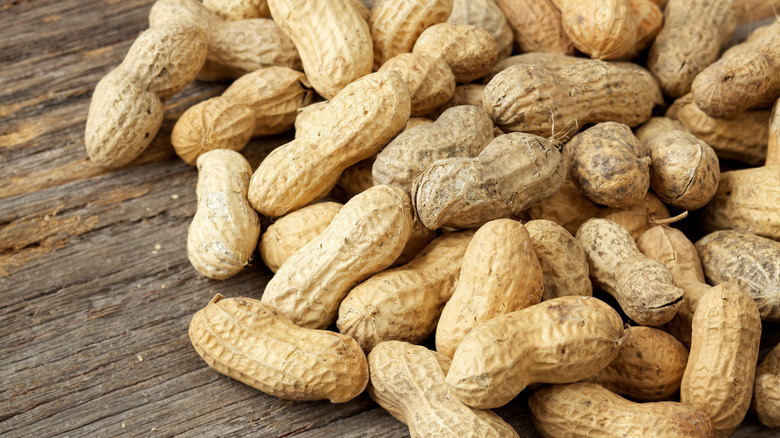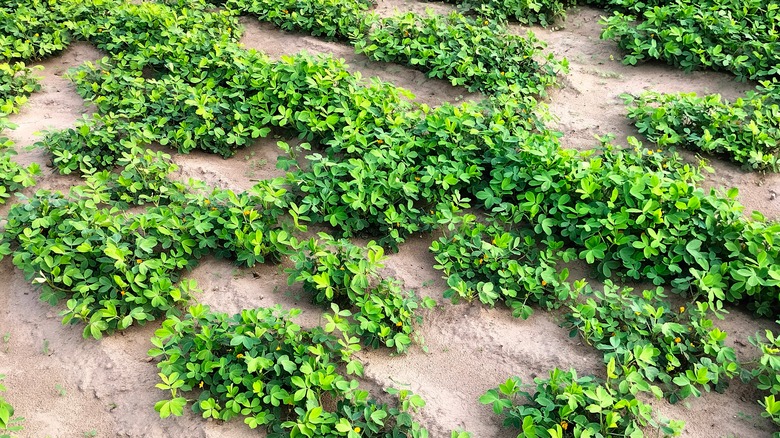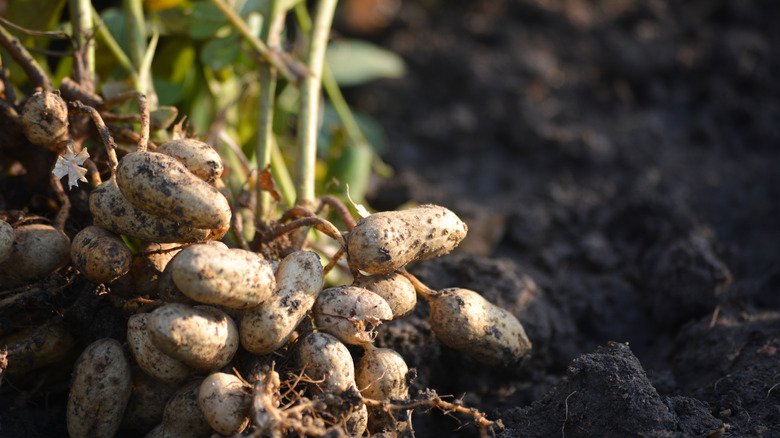Peanuts Don't Grow On Trees, But Here's To How To Add Them To The Garden
Peanuts are a classic American snack. You might feel like a baseball game is even more enjoyable while munching on a handful of these iconic legumes. Plenty of nut trees will bring a bountiful harvest to your yard, but peanuts are not among them. Commonly thought of as a nut, Arachis hypogea is actually a legume, more closely related to green peas than almonds. There's no need to clear a swath of your yard for a new tree if you want to plant peanuts because they grow largely underground.
Native to South America, peanuts grow well in the southern states. With only around 10% of the country known for growing most peanuts, chances are you've dismissed the thought of growing this treat in your own garden. If you're feeling experimental this season and are lucky enough not to have a peanut allergy, why not free up some space in your garden or patio for some peanuts? If you can provide your plants between 110 and 160 days with temperatures above the upper 40s, you can have a shot at a crop of this fascinating edible.
How to grow peanuts in a variety of climates
Peanuts are hardy in USDA zones 6 through 11, making them feasible crops for states much farther north than most people tend to think. In the right areas of states as far north as Maine, Michigan, and Montana, you may be able to plant peanuts directly in your garden. However, with creative strategies, gardeners in USDA zones as cool as 2 can successfully grow peanuts, especially if they opt for varieties that produce in as few as 90 days, such as early Spanish peanuts. Remember that most early-producing plants take 110 days or more to mature.
You can grow peanuts in your outdoor garden if you live in their hardiness zones. Starting seeds indoors is also a great way to give peanuts a head start if your area isn't blessed with a long growing season. Also, give season extenders or container gardening a try. Peanuts grow best at temperatures 85 degrees Fahrenheit and higher, so hoop houses, cold frames, and sheltered pots on patios can make growing peanuts possible in areas as far north as Alaska.
Planting and caring for peanuts
It's time to prep your soil for successful planting! Peanuts prefer sandy soil but can grow well in other types of soil, especially if you loosen it before planting. If a test tells you that your garden bed needs amending, till a fertilizer or a small amount of compost into the top 6 inches of the soil.
Once the ground is 65 degrees Fahrenheit or warmer, plant seeds in rows of hills spaced 2 feet apart. Plant seeds 1 ½ inches deep, 18 inches apart, with four seeds to a hill. Most peanut seeds will come in the shell, and shelling them will help seeds germinate more quickly. Water regularly, and don't allow the soil to dry completely. When your plants are about 1 foot high, mound about 6 inches of soil around their bases and mulch the hills. Like potatoes, the soil mounds allow the edible parts of the plant more room to grow and have better drainage.
Once your plants bloom, this is where the magic begins. Peanuts mature underground from "pegs" that grow from the stem above ground. After the plant flowers, it sends the "pegs" into the soil, where peanuts begin to form. From planting to harvest, expect peanuts to take four to five months. You'll know when to harvest when the plant's leaves start to yellow, or you can harvest right before your first frost.


